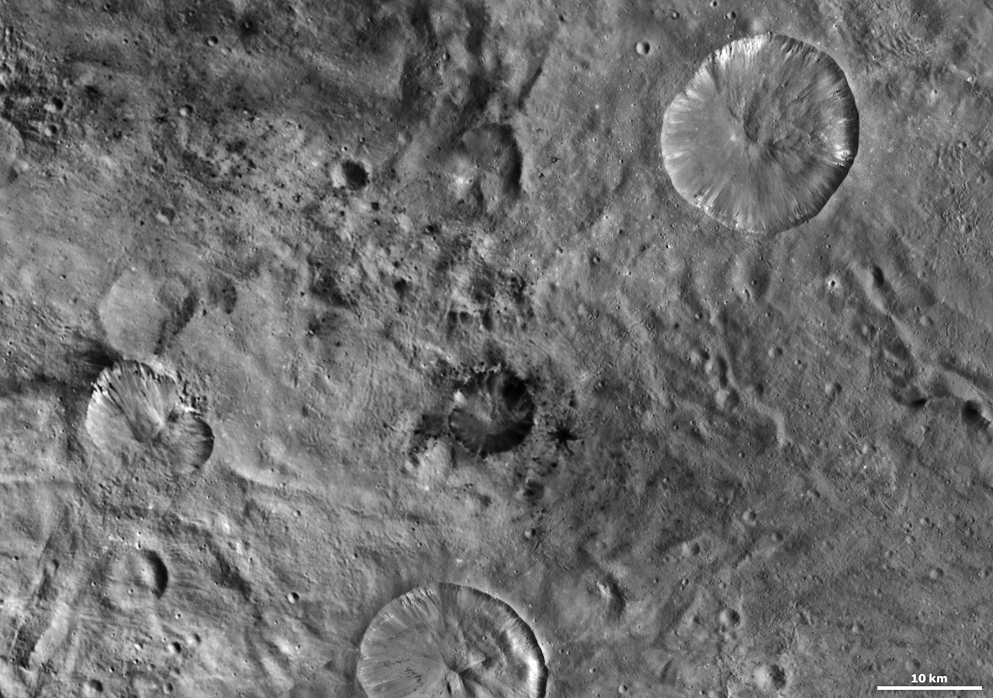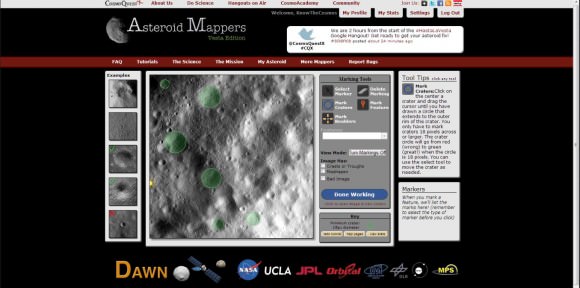Many types of craters are captured in this panorama of recent Dawn images. Credit: NASA
There’s a new citizen science project in town, and this one will allow you to be among the first to see high-resolution, stunning images of Vesta from the Dawn mission. Called AsteroidMappers, the project asks the public to help the Dawn mission scientists to identify craters, boulders and other features on Vesta’s surface. “If you’ve already been addicted to MoonMappers, you’ll be even more addicted to AsteroidMappers!”said Nicole Gugliucci from CosmoQuest, home to several citizen science projects.
As you know, Dawn has been in orbit of the asteroid Vesta, but just recently left orbit and is now on its way to Ceres. This is a first in space exploration, where a spacecraft orbits one body and then leaves to go on to another. This can only be accomplished because of Dawn’s revolutionary ion engine.
The goal of the Dawn mission is to characterize the conditions and processes of the solar system’s earliest epoch by investigating in detail two of the largest protoplanets remaining intact since their formations. Ceres and Vesta both reside in the asteroid belt, but yet each has followed a very different evolutionary path constrained by the diversity of processes that operated during the first few million years of solar system evolution.
Even the Dawn scientists have been amazed at what they’ve seen at Vesta.
“We have acquired so much more data than we had planned even in late 2011,” Dr. Marc Rayman, the mission’s Chief Engineer, told Universe Today in a previous article. “We have conducted a tremendous exploration of Vesta – the second most massive body between Mars and Jupiter, a giant of the main asteroid belt.”
With AsteroidMappers (Vesta Edition), you’ll be helping the Dawn scientists learn more – not only about Vesta, but about how our solar system evolved.
As with every CosmoQuest project, there is a tutorial to help you get started. But the work area is fairly intuitive, with instructions and hints along the way.
The Dawn scientists have not yet released to the public all the images, so by working on this citizen science project, you’ll be looking at pristine images that perhaps no one else has seen before. The images are absolutely beautiful, as Vesta has turned out to be even more fascinating than expected, with huge impact basins, steep cliffs and unusual features on its surface.
“Vesta is unlike any other object we’ve visited in the solar system,” said Dawn mission team member Vishnu Reddy. “We see a wide range of variation on the surface, with some areas bright as snow, and other areas as dark as coal.”
Scientists have said that Vesta more closely resembles a small planet or Earth’s Moon than another asteroid, and they now have a better understanding of both Vesta’s surface and interior, and can conclusively link Vesta with meteorites that have fallen on Earth.
So, check out AsteroidMappers and enjoy the views! As @therealjason said on Twitter, “I don’t map Vesta very often, but when I do, I choose @cosmoquestX – Stay curious, my friends.”


